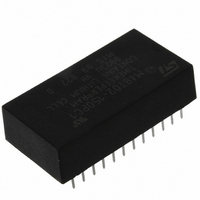M48T02-70PC1 STMicroelectronics, M48T02-70PC1 Datasheet - Page 14

M48T02-70PC1
Manufacturer Part Number
M48T02-70PC1
Description
IC TIMEKPR NVRAM 16KBIT 5V 24-DI
Manufacturer
STMicroelectronics
Series
Timekeeper®r
Type
Clock/Calendar/NVSRAMr
Datasheet
1.M48T12-150PC1.pdf
(25 pages)
Specifications of M48T02-70PC1
Memory Size
16K (2K x 8)
Time Format
HH:MM:SS (24 hr)
Date Format
YY-MM-DD-dd
Interface
Parallel
Voltage - Supply
4.75 V ~ 5.5 V
Operating Temperature
0°C ~ 70°C
Mounting Type
Through Hole
Package / Case
24-DIP (600 mil) Module
Function
Clock/Calendar/NV Timekeeping RAM/Battery Backup
Rtc Memory Size
2048 Byte
Supply Voltage (max)
5.5 V
Supply Voltage (min)
4.75 V
Maximum Operating Temperature
+ 70 C
Minimum Operating Temperature
0 C
Mounting Style
Through Hole
Rtc Bus Interface
Parallel
Lead Free Status / RoHS Status
Lead free / RoHS Compliant
Other names
497-2827-5
Available stocks
Company
Part Number
Manufacturer
Quantity
Price
Company:
Part Number:
M48T02-70PC1
Manufacturer:
ST
Quantity:
5 510
Company:
Part Number:
M48T02-70PC1
Manufacturer:
HITACHI
Quantity:
5 510
Part Number:
M48T02-70PC1
Manufacturer:
ST
Quantity:
20 000
Clock operations
Note:
Note:
14/25
'1' indicates positive calibration, '0' indicates negative calibration. Calibration occurs within a
64 minute cycle. The first 62 minutes in the cycle may, once per minute, have one second
either shortened by 128 or lengthened by 256 oscillator cycles. If a binary '1' is loaded into
the register, only the first 2 minutes in the 64 minute cycle will be modified; if a binary 6 is
loaded, the first 12 will be affected, and so on.
Therefore, each calibration step has the effect of adding 512 or subtracting 256 oscillator
cycles for every 125,829,120 actual oscillator cycles; that is +4.068 or –2.034 ppm of
adjustment per calibration step in the calibration register. Assuming that the oscillator is in
fact running at exactly 32,768 Hz, each of the 31 increments in the calibration byte would
represent +10.7 or –5.35 seconds per month which corresponds to a total range of +5.5 or
–2.75 minutes per month.
Two methods are available for ascertaining how much calibration a given M48T02/12 may
require. The first involves simply setting the clock, letting it run for a month and comparing it
to a known accurate reference (like WWV broadcasts). While that may seem crude, it allows
the designer to give the end user the ability to calibrate his clock as his environment may
require, even after the final product is packaged in a non-user serviceable enclosure. All the
designer has to do is provide a simple utility that accesses the calibration byte.
The second approach is better suited to a manufacturing environment, and involves the use
of some test equipment. When the Frequency Test (FT) bit, the seventh-most significant bit
in the day register, is set to a '1,' and the oscillator is running at 32,768 Hz, the LSB (DQ0) of
the seconds register will toggle at 512 Hz. Any deviation from 512 Hz indicates the degree
and direction of oscillator frequency shift at the test temperature. For example, a reading of
512.01024 Hz would indicate a +20 ppm oscillator frequency error, requiring
–10 (WR001010) to be loaded into the calibration byte for correction.
Setting or changing the calibration byte does not affect the frequency test output frequency.
The device must be selected and addresses must be stable at address 7F9 when reading
the 512 Hz on DQ0.
The FT bit must be set using the same method used to set the clock: using the WRITE bit.
The LSB of the seconds register is monitored by holding the M48T02/12 in an extended
READ of the seconds register, but without having the READ bit set. The FT bit MUST be
reset to '0' for normal clock operations to resume.
It is not necessary to set the WRITE bit when setting or resetting the frequency test bit (FT)
or the stop bit (ST).
For more information on calibration, see the application note AN924, “TIMEKEEPER
calibration.”
Doc ID 2410 Rev 8
M48T02, M48T12
®















